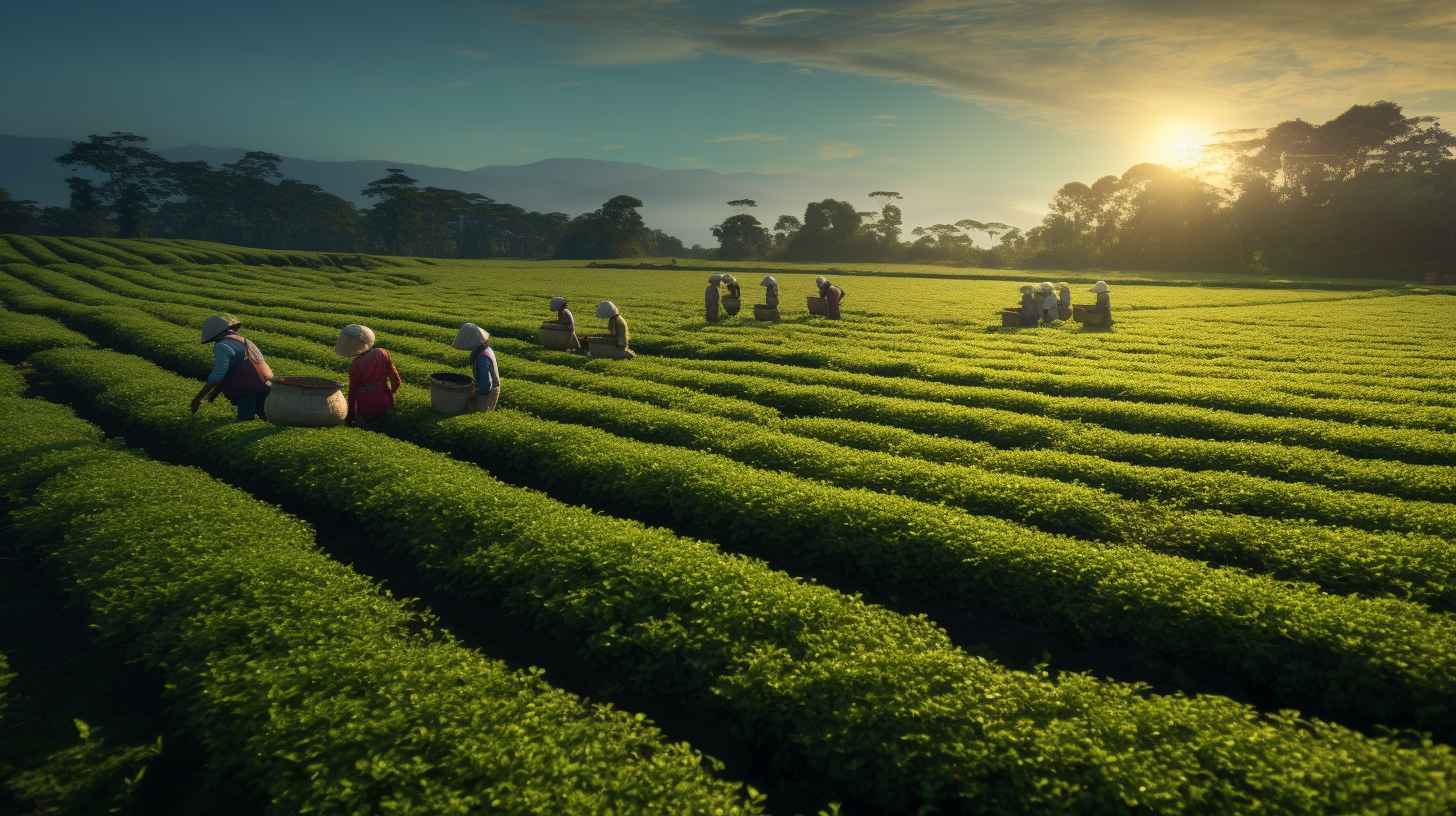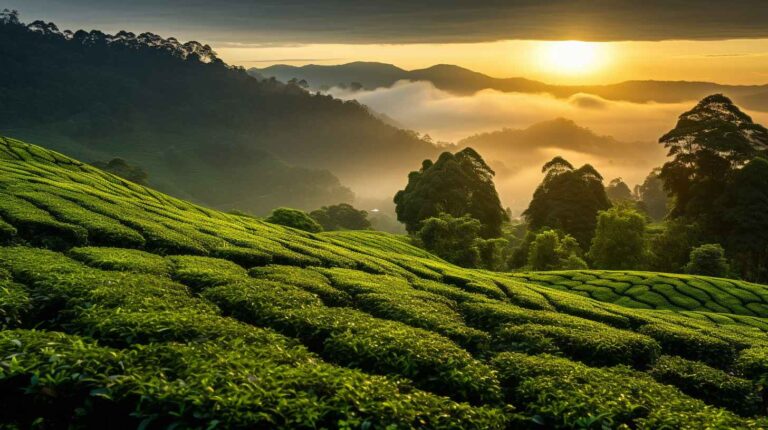The British Empire and the Commercialization of Assam Tea
Introduction
The allure of tea has been a compelling narrative that transcends time and borders. This warm elixir, with its diverse flavors and soothing properties, has played a part in shaping the course of human history. At the center of its story stands the British Empire and its tryst with Assam tea. While this chapter of tea’s history showcases the spirit of exploration, it also delves into the realms of exploitation and commercial triumph. Today, we’ll take a more in-depth look into the British Empire’s role in both discovering and propelling Assam tea to worldwide acclaim.
Discovery of Assam Tea
Long before Assam tea graced the tea tables of Europe, tea itself had a rich history. The ancient tales and folklore of tea find their roots in China, dating back nearly 5,000 years. Here, in the misty mountains and sprawling terrains, tea was considered a medicinal brew, eventually finding its place in cultural ceremonies and daily life.
Fast forward to the 19th century, the British had already cultivated an unquenchable thirst for tea, primarily relying on Chinese imports. This dependency led them on a quest to find alternate sources. Their quest bore fruit in the lush terrains of Assam, India. In a serendipitous discovery in 1823, Robert Bruce, a Scottish adventurer, chanced upon wild tea plants. These weren’t just any tea plants, but a unique variety that was different from the Chinese variant.
Engaging with the local Singpho tribe, Bruce gathered insights into the tea’s cultivation and traditional brewing methods. The indigenous methods of preparing tea involved roasting leaves and then brewing them, which was different from the usual green or black tea preparations. Though Bruce couldn’t pursue his discovery due to his untimely death, the baton was passed to his brother, Charles Alexander Bruce. He recognized the potential and embarked on the mission of commercializing Assam tea.
The Need for an Alternative to Chinese Tea
Britain’s love affair with tea began in the 17th century, and by the 19th century, this fondness had turned into an obsession. Tea was no longer a luxury but had become a staple, essential for the British way of life. The daily routines, from morning breakfasts to evening high teas, revolved around this beverage.
But there was a catch. The British Empire’s almost complete reliance on Chinese tea led to a significant trade imbalance. Silver coins from Britain’s coffers flowed steadily into China, tipping the economic scales unfavorably for Britain. Such an unsustainable trade relationship laid the foundation for tensions, culminating in the infamous Opium Wars. This conflict, driven in part by Britain’s attempt to address the trade deficit by exporting opium to China, had far-reaching political and social implications.
In this backdrop, the importance of discovering an alternative tea source became even more pronounced. Assam, with its native tea plants, seemed like the answer to Britain’s prayers, offering a chance to break free from Chinese monopolistic control.
Establishment of Tea Plantations
With Assam identified as a potential goldmine for tea cultivation, the wheels of the British East India Company began turning rapidly. Vast stretches of Assam’s virgin forests were transformed into sprawling tea estates. The landscape of Assam began to change, with rows of tea bushes dominating the horizon by the 1830s.
Yet, challenges persisted. The local Assamese, used to their traditional agricultural practices, found the labor-intensive methods of the British daunting. The solution, albeit a problematic one, was to look for labor elsewhere.
To bridge this gap, the British Empire began importing labor from other parts of India, focusing primarily on the regions of Bihar and Orissa. While this ensured a steady workforce, it also introduced a system rife with exploitation. Workers were often lured with false promises, only to be met with abysmal living conditions and paltry wages. The social fabric of Assam began to transform, with the influx of these laborers, setting the stage for both cultural exchanges and tensions.
Commercial Success and Global Recognition
With the foundation laid for large-scale tea production in Assam, the 19th century witnessed a steady ascent of Assam tea on the global stage. The reasons for its rising popularity were manifold. Apart from breaking the dependence on Chinese tea, Assam tea brought its unique flavor profile – bold, robust, and malty. This resonated well with the British palate, particularly when paired with milk and sugar, an emerging trend in British tea consumption.
But the success wasn’t solely due to its taste. A great deal of strategic planning went into establishing Assam as a powerhouse of tea production. The British Empire invested heavily in the infrastructure of the region. The dense forests of Assam were interspersed with roads that led to newly developed ports. These ports became the hub of tea export, with ships laden with Assam’s finest heading to Britain’s shores.
The coming of railways further bolstered this growth. The Assam Railways and Trading Company, founded in the latter part of the 19th century, played a pivotal role in transporting tea from the remote plantations to the bustling ports. With these infrastructural advances, Assam was well on its way to becoming a global tea titan.
By the time the 19th century drew to a close, Assam had not only dethroned China from its position of the world’s largest tea producer but had also established itself as a brand. Assam tea found its way into households across Europe, the Americas, and even parts of Africa, symbolizing both luxury and everyday comfort.
Competition and Diversification
With Assam firmly on the tea map, the British Empire, always on the lookout for growth and diversification, started venturing into other regions. Their exploratory zeal led them to the misty hills of Darjeeling and the blue mountains of Nilgiris in India. Both regions offered a different flavor profile from Assam. Darjeeling tea, often referred to as the “Champagne of Teas,” is known for its delicate aroma and muscatel flavor, while Nilgiri tea is aromatic and bright.
Outside of India, the British eyes turned to the island nation of Sri Lanka, then known as Ceylon. The favorable climatic conditions of Ceylon were perfect for tea cultivation. Soon, Ceylon tea, with its bold and brisk characteristics, became another feather in the cap of the British tea industry.
This diversification strategy was twofold. Firstly, it ensured that the empire had a backup in case of crop failures in one region. Secondly, the variety catered to the diverse tastes of the British populace, ensuring that the empire’s hold on the global tea market remained unchallenged.
Impact on Local Culture and Economy
The ripples of Assam tea’s commercialization were felt deeply within the socio-economic fabric of Assam. On the one hand, it brought about undeniable development. Roads, railways, and ports sprouted, connecting Assam to the rest of India and the world. The previously isolated region saw an influx of diverse populations, leading to a melting pot of cultures. Assamese cuisine, music, and festivals began to incorporate influences from the migrant communities, giving rise to a unique cultural synthesis.
However, this commercial boom was not without its drawbacks. The local tribes and communities, once the primary inhabitants of Assam, found themselves marginalized. Their traditional lands were often taken over for plantations, leading to displacement. The influx of outside labor also led to occasional skirmishes and cultural misunderstandings. Over time, as the indigenous communities saw their influence wane, there was a palpable sense of loss of identity and cultural heritage.
Moreover, the plantation economy, while profitable for the British, often meant that the wealth didn’t trickle down to the local populace. The disparity between the plantation owners and the laborers was stark, leading to social stratifications that persist in some form even today.
Conclusion
The saga of Assam tea, under the aegis of the British Empire, is a complex tapestry of enterprise, ambition, success, and cultural shifts. While Assam tea continues to warm millions of hearts and souls with its rich flavor, its history serves as a poignant reminder of the interplay of commerce, culture, and colonization.
Every cup of Assam tea is a testament to human endeavor – from the indigenous tribes who first cultivated it to the laborers who toil in the plantations and the merchants who brought it to the world. It’s a story that beckons reflection, urging us to savor not just the taste but also the rich history and legacy that accompanies every sip.






